What Is a Heart Attack??
We all know the symptoms. Pain shooting down the left arm. The jaw feeling as if it’s going to be ripped from the cranium. The lungs desperately struggling for air. A tightness, spreading from the upper back to the chest, intensifying moment to moment. We’ve all heard these time and time again in movies, TV shows, and hearing stories from friends and family members. Even so, do you really know what’s happening to the heart?
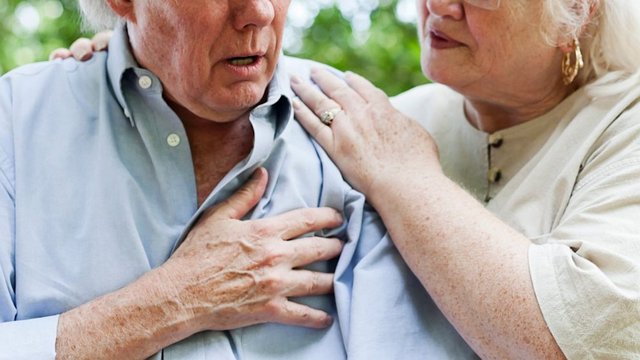
Credit: http://abcnews.go.com/Health/Wellness/heart-attack-symptoms-women-ignore/story?id=22418785
A Role Model of Physiology
The heart is the most resilient organ in the body. While the contraction of skeletal and smooth muscle is controlled by the nervous system, the heart is capable of causing itself to beat, independent of nervous impulses. I’m sure you’ve heard of someone being ‘brain dead’ before, but have you stopped to think how the rest of the body is still living?
Just think to yourself how incredibly consistent the heart must be in order to supply your entire body with blood every second of every day, for your entire life. It equates to somewhere around 3 billion beats over an average lifetime. That’s well over 100,000 beats per day, and somewhere around 42 million beats per year.
If we think in terms of volume, the heart pushes somewhere around 1/3 of a cup of blood per beat, and somewhere around 2,000 gallons of blood per day. Over an average lifetime, your heart is pumping something like 58 million gallons of blood through your blood vessels.

Credit: https://www.walgreens.com/store/c/milk-whole-1-gallon/ID=prod6044342-product
The heart is the epitome of efficiency and persistence. If you took a heart out of the body, it would continue to beat as long as it had oxygen supplying its muscle tissue. In fact, the heart has its own fallback systems to continue beating when all else fails. There’s no denying that the heart is the workhorse of the body.
So then, what is a heart attack?
The medical term of heart attack is Myocardial Infarction. If you break down the word, myo means muscle, cardial means heart, and infarction means tissue death from a lack of oxygen. However, this doesn’t really explain what’s really going on here. How does it lose oxygen? Why are the symptoms almost the same across the board, from individual to individual (females can differ)? What’s so special about blood in the first place?
It's All About Plumbing
The heart is a 4 chambered marvel of evolution. Originally, as life evolved in the oceans of our planet, it was so incredibly simple that the water it evolved in provided all the nutrition it needed. But as life became more complex, an irrigation network was needed in order to provide the tissues with the essential nutrition for survival. Blood vessels weaved their way in and out of every nook and cranny in the body, penetrating even the deepest and darkest regions, allowing nature to create more and more complex animals due to this amazing irrigation network. But more than just vessels was needed – a pump was required to push the fluid to the most distal regions of the body, as well as against gravity.
Besides supplying the body with nutrients, via the blood, the heart must supply itself. After all, the heart needs the nutrition just as much as every other tissue in the body does. It does this through what are known as the coronary arteries.
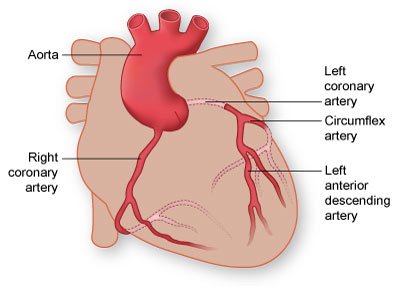
Credit: http://www.texasheart.org/HIC/Anatomy/coroanat.cfm
The coronary arteries branch off of the largest artery in the body, the aorta. Upon the first half of the heart beat (think the lub in the lub dub sound), blood flows from what are called the atria, into the ventricles. When the second half of the heart beat occurs (the dub), blood is pumped out of the ventricles into either the aorta or pulmonary arteries.
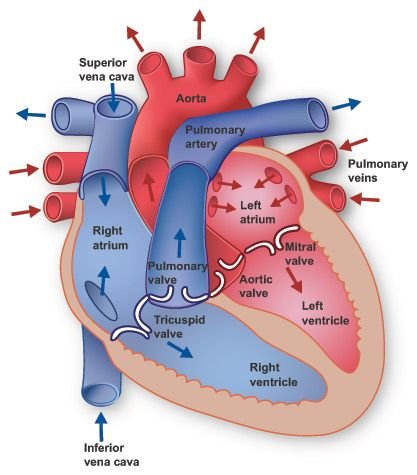
Credit: https://www.pinterest.com/explore/human-heart/
While the aorta is huge (about the diameter of a garden hose), the coronary arteries are not. While still big in comparison to other arteries in the body, they are by no means close to the garden hose size of the aorta. The coronary arteries continue to branch into smaller and smaller arteries, each of which supplies different parts of the heart with blood.
This is where the story of a heart attack begins.
It All Comes Tumbling Down
Heart attacks can have multiple causes. Usually it’s attributed to cholesterol, fat, smoking, alcohol, etc. For our purposes, we aren’t going to focus on what caused it (that’ll be for another post), but instead on what happens to the heart because of whatever caused it in the first place.
You’re probably not surprised that heart attacks are caused by a blockage of the coronary arteries. Based upon what we’ve learned thus far, you can also probably already see why blocking the coronary arteries is so problematic.
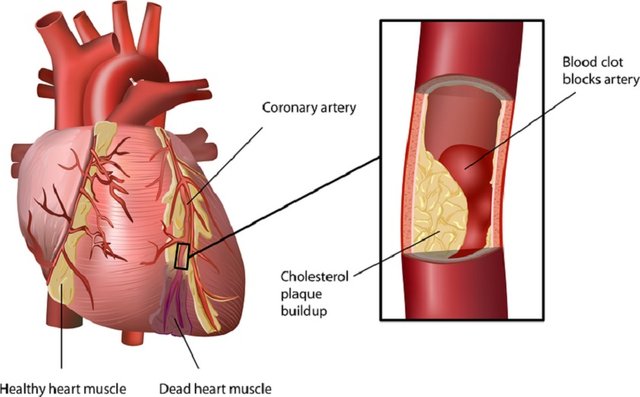
Credit: http://www.myhealthylivingcoach.com/heart-block-vein-natural-remedy/
When the coronary arteries are blocked, blood supply is reduced, if not completely shut off. This causes a cascade of events within the heart to occur.
As the heart tissue begins to experience blood loss, the various muscle cells downstream of the blockage start to experience hypoxia which is just a lack of oxygen. While any stoppage of nutrients is problematic, it’s the lack of oxygen that we’re really concerned with. Without oxygen, energy in the form of ATP, or adenosine triphosphate, cannot be created. Without ATP, the vast majority of cellular functioning cannot occur.
Every cell in the body creates some sort of metabolic waste through its normal day-to-day functions. Normally, ATP would assist in the removal of this waste. However, if there is no ATP to facilitate the removal of the waste, it accumulates to the point where it begins to damage the muscle cell. If the heart attack is continuing untreated, cardiac muscle cells will start to literally disintegrate, leaving a literal gap in the heart that is completely useless in terms of functionality. It will be filled scar tissue, and there will always a weakness in that specific area of the heart.
The Mystery of Referred Pain
The pain that is associated with a heart attack most likely comes from a mix-up in the nervous pathway. This phenomena is called referred pain, and we still don’t fully understand all the how’s and why’s in regards to how they manifest. You’ve probably heard of referred pain before when people talk about kidney issues causing low back pain, and appendicitis causing extreme pain in the lower right abdomen. We know how to identify certain issues because of how specific the referred pain is, but that doesn’t mean we fully understand it.
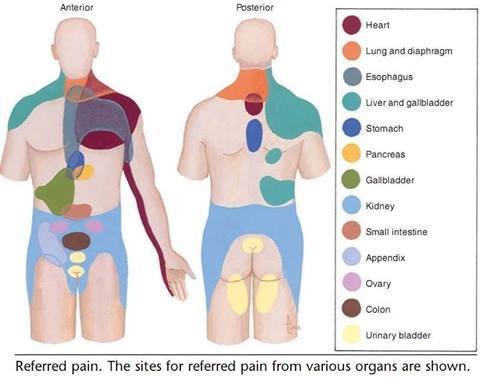
Credit: https://mycerebellarstrokerecovery.com/2014/11/21/referred-pain/
With that being said, the heart and upper limbs do share common innervation with one another. The most likely reason for individuals experiencing arm and jaw pain is that the brain simply isn’t used to getting pain signals from the heart itself. The brain interprets this pain coming from the limbs, seeing as that is far more likely, and the result is pain, numbness, and overall weakness is the upper limbs.
Shortness of breath is another common symptom of a heart attack. The reason is very simple. The heart is essentially divided into two halves: the left side is oxygenated, and the right side is deoxygenated. We’ve already discussed how the left pumps blood to the entirety of the body, but the right side only needs to pump the blood to the lungs to acquire the oxygen inhaled through the respiratory tract. Considering the heart is already experiencing a lack of oxygen due to a blockage, the inability to contract properly reinforces this issue by making it more difficult to re-oxygenate the blood in the lungs themselves. The end result is the feeling of fatigue, and shortness of breath.
The Need to Know
So then, what is a heart attack?
A heart attack is muscle tissue dying from a lack of oxygen brought on by some type of blockage to the muscle of the heart itself.
This muscle necrosis vastly decreases the efficiency and resilience of the heart. With less muscle cells to contract and supply the body (most importantly the brain) with blood, the body begins to shut down. The longer the attack goes untreated, the worse the situation becomes. Within 20-30 minutes of the onset of the attack, the cardiac cells will die, never to return. If enough muscle tissue dies, nothing other than a heart transplant will suffice. The patient will die from an inability to supply the body with oxygen.
If you or a loved one are experiencing symptoms similar to the ones we've discussed, it's better to err on the side of caution and seek medical assistance. The quicker the issue is addressed, the better the chances are of survival and a higher quality of life.
I think that everybody should know facts about heart attack, what causes it and how we can fight with it but primarily what causes it. These days people don't have time to think about their health, because they live in pursuit of succes or their experience. Nice post so I will follow you! I'll waiting for more information about this and more! Thank you for sharing and have a great day! <3 :)
I couldn't agree more. Our body is the one thing we carry with us for the entirety of our lives, yet know startlingly little about. Thanks for the input!!
Really good info, this has peaked my curiosity. I wonder how many heart attacks there are a year...
Every year about 735,000 Americans have a heart attack. Of these, 525,000 are a first heart attack and 210,000 happen in people who have already had a heart attack. https://www.cdc.gov/heartdisease/facts.htm
Wow, I had no idea it was that many. Heart attacks aren't going away any time soon, and the more people know about them, the better.
Congratulations @justincottle! You have completed some achievement on Steemit and have been rewarded with new badge(s) :
Click on any badge to view your own Board of Honor on SteemitBoard.
For more information about SteemitBoard, click here
If you no longer want to receive notifications, reply to this comment with the word
STOPReally interesting stuff, and well written. It's nice to see some more medical related posts on steemit!